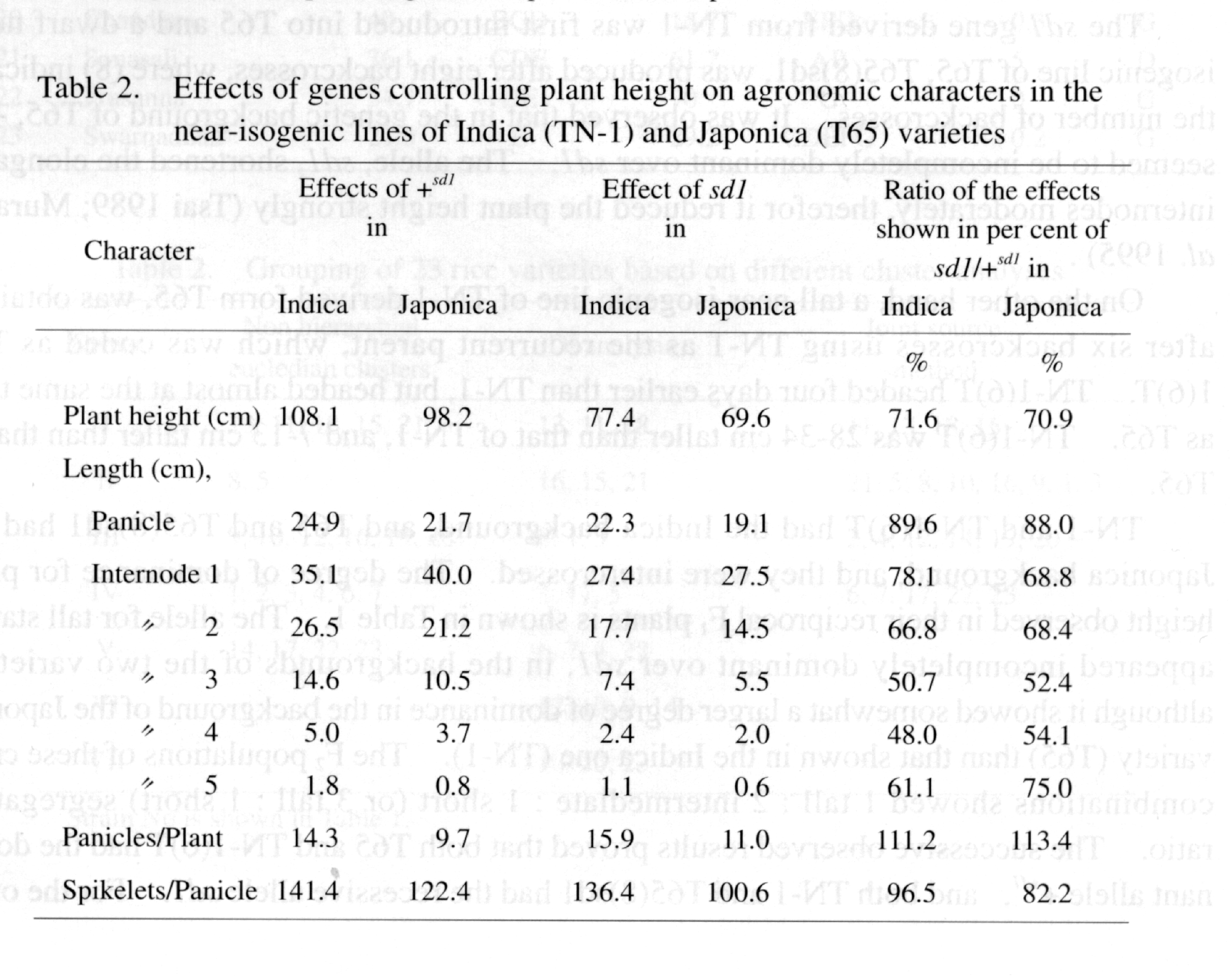|
14.
|
Effects of genes controlling plant height in near-isogenic
lines of Indica and
|
Japonica cultivars
K.H. TsM
Department of Agronomy, National Chung Hsing University,
Taichung, Taiwan 40227
We have two famous rice varieties in Taiwan. Taichung-Native
1 (abbr. TN-i) is the first Indica variety carrying the well known Dee-geo-woo-gene
semidwarfing gene, sdi (previous symbol was sd-i; Suh and Heu 1978 ; Kikuchi
and Ikehashi 1984 : Tsai 1991 Linkage group 1). This semidwarf variety
was selected from a cross of Dee-geo-woogene x Tsai-yuan-chung in 1949
(Huang et a!. 1972), which contributed to the “Green Revolution” in rice
(Oka 1974). Taichung 65 (T65) is a Japonica rice variety selected from
a cross between two Japanese varieties, Kameji and Shinriki, around 1923
(Iso 1957). T65 is well known for its wide adaptability (Matsuo et a!.
1972), and has tall stature (Tsai 1989).
The sdi gene derived from TN-i was first introduced into
T65 and a dwarf nearisogenic line of T65, T65(8)sd1, was produced after
eight backcrosses, where (8) indicates the number of backcrosses. It was
observed that in the genetic background of T65, +sdl, seemed to be incompletely
dominant over sd1. The allele, sdi, shortened the elongated internodes
moderately, therefor it reduced the plant height strongly (Tsai 1989; Murai
et a!. 1995).
On the other hand, a tall near-isogenic line of TN-i derived
form T65, was obtained after six backcrosses using TN-i as the recurrent
parent, which was coded as TN1(6)T. TN-1(6)T headed four days earlier than
TN-i, but headed almost at the same time as T65. TN-1(6)T was 28-34cm taller
than that of TN-i, and 7-13 cm taller than that of T65.
TN-i and TN-1(6)T had the Indica background, and T65 and
T65(8)sdl had the Japonica background, and they were intercrossed. The
degree of dominance for plant height observed in their reciprocal F1 plants
is shown in Table 1. The allele for tall stature appeared incompletely
dominant over sdi, in the backgrounds of the two varieties, although it
showed somewhat a larger degree of dominance in the background of the Japonica
variety (T65) than that shown in the Indica one (TN-i). The F2 populations
of these cross combinations showed 1 tall : 2 intermediate : 1 short (or
3 tall : 1 short) segregation ratio. The successive observed results proved
that both T65 and TN- 1(6)T had the dominant allele +sdl, and both TN-i
and T65(8)sd1 had the recessive allele sdi. For the other
|


crosses, their F1’s tended to show the overdominance for
tallness, and the F2 populations showed the transgressive type of segregation
(Table 1).
The agronomic characters expressed by the two alleles, +sdl
and sdl, were compared in the different backgrounds of Indica and Japonica
cultivars. Regarding the effects of the allele +sdl, the Indica variety,
when compared to the Japonica, had longer panicle and internodes, except
for a shorter first internode. With the allele +sdl, the plant height of
the Indica variety was 5 to 10 cm greater than that of the Japonica variety.
The Indica variety with +sdl seemed to have favorable yield characters,
but it proved to be lodging susceptible due to its longer lower internodes.
In general, the variety with dwarfing gene shows shorter internodes and
plant height than those of the tall variety. The gene sdl almost equally
reduced the plant height, panicle length and upper intemodes in the both
varietal backgrounds. But, it seems the sdl tended to reduce the lower
internodes more in the Indica variety than those in the Japonica variety.
Moreover, it did not affect spikelet number per panicle (Table 2). This
gene may be useful in breeding Indica variety.
References
Falconer, D.S., 1960. Introduction to quantitative genetics.
Olive and Boyd, London. 365pp.
Huang, C.H., W.L. Chang and T.T. Chang, 1972. Ponlai varieties
and Taichung Native 1. In “Rice Breeding”, Pub. by IRRI. pp. 31 46.
Iso, E., 1957. Lecture on rice culture. Department of Economics,
Ryukyu District Government. 49lpp. (in Japanese)
Kikuchi, F. and H. Ikehashi, 1984. Semidwarfing genes of
high yielding rice varieties in Japan. RON 1: 93-
94.
Matsuo, T., F. Kikuchi and K. Kumagai, 1972. Studies on the
adaptability of rice. 1. Comparative studies on the adaptability of rice
varieties tested under different conditions in temperate zone. Japan. J.
Breed. 22
:83-91.
Mural, M., N. Shinbashi, S. Sato, K. Sato, H. Araki and M.
Ehare, 1995. Effect of the dwarfing gene from Deegeo-woo-gene on cuim and
internode lengths, and its response to fertilizer in rice. Japan. J. Breed.
45:
7-14.
Oka, H.I., 1974. A short history of the first hybrid semidwarf
rice variety, Taichung native I. SABRAO Journal 6: 241-243.
Shu, H.S. and M.H. Heu, 1978. The segregation mode of plant
height in the cross of rice varieties. XI. Linkage analysis of the semidwarfness
of rice variety “Tongil” Korean J. Breed. 10: 1-6.
Tsai, KU., 1989. An induced dwarfing gene, sd-7, obtained
in Taichung 65. RGN 6: 99-101.
Tsai, K.H., 1991. Chromosomal location of gene, sd-i, examined
with isogenic translocation lines of Taichung
65.RGN8: 109-110.

